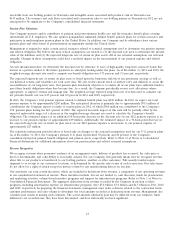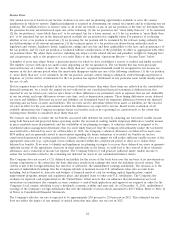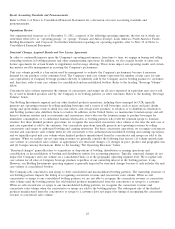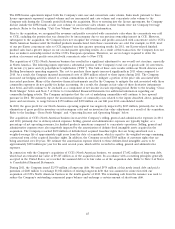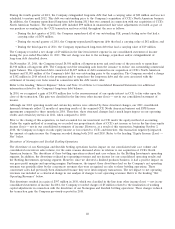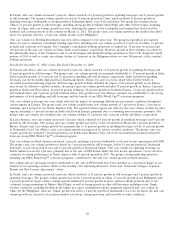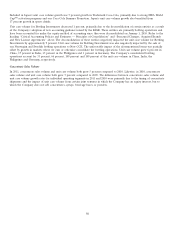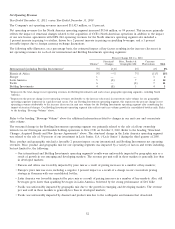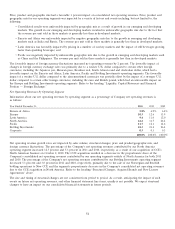Coca Cola 2011 Annual Report Download - page 47
Download and view the complete annual report
Please find page 47 of the 2011 Coca Cola annual report below. You can navigate through the pages in the report by either clicking on the pages listed below, or by using the keyword search tool below to find specific information within the annual report.The DPS license agreements impact both the Company’s unit case and concentrate sales volume. Sales made pursuant to these
license agreements represent acquired volume and are incremental unit case volume and concentrate sales volume to the
Company only during the 12-month period following the acquisition. Prior to entering into the license agreements, the Company
did not include the DPS brands as unit case volume or concentrate sales volume, as these brands were not Company beverage
products. Refer to the heading ‘‘Unit Case Volume’’ below for additional information.
Prior to the acquisition, we recognized the revenues and profits associated with concentrate sales when the concentrate was sold
to CCE, excluding the portion that was deemed to be intercompany due to our previous ownership interest in CCE. However,
subsequent to the acquisition, the Company does not recognize the revenues and profits associated with concentrate sold to CCE’s
North American business until the finished products manufactured from those concentrates are sold. For example, in 2010, most
of our pre-Easter concentrate sales to CCE impacted our first quarter operating results. In 2011, our Easter-related finished
product sales had a greater impact on our second quarter operating results. As a result of this transaction, the Company does not
have an indirect ownership interest in New CCE’s European operations. Therefore, we are no longer required to defer the
portion of revenues and profits associated with concentrate sales to New CCE.
The acquisition of CCE’s North American business has resulted in a significant adjustment to our overall cost structure, especially
in North America. The following inputs represent a substantial portion of the Company’s total cost of goods sold: (1) sweeteners,
(2) metals, (3) juices and (4) polyethylene terephthalate (‘‘PET’’). The bulk of these costs resides within our North America and
Bottling Investments operating segments. The cost to purchase these inputs increased significantly in 2011 when compared to
2010. As a result, the Company incurred incremental costs of $800 million related to these inputs during 2011. The Company
increased our hedging activities related to certain commodities in order to mitigate a portion of the price risk associated with
forecasted purchases. Many of the derivative financial instruments used by the Company to mitigate the risk associated with these
commodity exposures do not qualify for hedge accounting. As a result, the changes in fair value of these derivative instruments
have been, and will continue to be, included as a component of net income in each reporting period. Refer to the heading ‘‘Gross
Profit Margin’’ below and Note 5 of Notes to Consolidated Financial Statements for additional information regarding our
commodity hedging activity. The Company anticipates that the cost of underlying commodities will continue to face upward
pressure in 2012. We currently expect the incremental impact of commodity costs related to the inputs described above, primarily
juices and sweeteners, to range between $350 million and $450 million on our full year 2012 consolidated results.
In 2010, the gross profit for our North America operating segment was negatively impacted by $235 million, primarily due to the
elimination of gross profit in inventory on intercompany sales and an inventory fair value adjustment as a result of the acquisition.
Refer to the headings ‘‘Gross Profit Margin’’ and ‘‘Operating Income and Operating Margin’’ below.
The acquisition of CCE’s North American business increased the Company’s selling, general and administrative expenses in 2011
and 2010, primarily due to delivery-related expenses. Selling, general and administrative expenses are typically higher, as a
percentage of net operating revenues, for finished products operations compared to concentrate operations. Selling, general and
administrative expenses were also negatively impacted by the amortization of definite-lived intangible assets acquired in the
acquisition. The Company recorded $650 million of definite-lived acquired franchise rights that are being amortized over a
weighted-average life of approximately eight years from the date of acquisition, which is equal to the weighted-average remaining
contractual term of the acquired franchise rights. In addition, the Company recorded $380 million of customer rights that are
being amortized over 20 years. We estimate the amortization expense related to these definite-lived intangible assets to be
approximately $100 million per year for the next several years, which will be recorded in selling, general and administrative
expenses.
In connection with the Company’s acquisition of CCE’s North American business, we assumed $7,602 million of long-term debt,
which had an estimated fair value of $9,345 million as of the acquisition date. In accordance with accounting principles generally
accepted in the United States, we recorded the assumed debt at its fair value as of the acquisition date. Refer to Note 2 of Notes
to Consolidated Financial Statements.
During 2011, the Company issued $2,979 million of long-term debt. We used $979 million of this newly issued debt and paid a
premium of $208 million to exchange $1,022 million of existing long-term debt that was assumed in connection with our
acquisition of CCE’s North American business in the fourth quarter of 2010. The remaining cash from the issuance was used to
reduce the Company’s outstanding commercial paper balance and exchange a certain amount of short-term debt.
45








